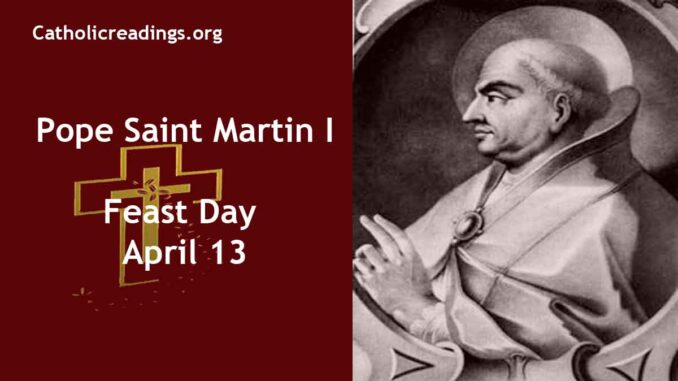Pope Saint Martin I was the pope of the Catholic Church between July 21 649 AD and September 16 655 AD.
He was born in the late 6th century in Todi, Tuscany, Italy, and died on September 16 655, Cherson, Crimea (now Kherson, Ukraine).
We celebrate his feast day on April 13 every year in the Catholic Church.
| St Martin I, Pope Biography | |
|---|---|
 |
|
| Date of Birth | Late 6th century |
| Place of Birth | Todi, Tuscany, Italy |
| Profession | Pope |
| Place of Work | Rome, Italy |
| Date of Death | September 16 655 AD |
| Place of Death | Cherson, Crimea (now Kherson, Ukraine). |
| Feast Day | April 13 |
| Canonization | Pre-Congregation |
| Patron Saint of | |
Pope St Martin I Life History
Pope Saint Martin I was born in a town close to Todi called Pian di San Martino, Umbria, Italy which was later named after him. He came from a noble family, possessed remarkable intelligence, and was known for his generosity towards the less fortunate.
Pope John IV dispatched Abbot Martin to Dalmatia and Istria in 641 AD to provide aid to the population and ransom captives taken during a Slavic invasion.
As many of the destroyed churches could not be restored, some of the significant saints’ relics from Dalmatia were transported to Rome, where an oratory was constructed by Pope John IV to honor them.
Martin later served as an apocrisiarius or legate in Constantinople during the early years of Theodore I’s papacy (642-49) and was a deacon at the time of his own election as Pope in 649 AD.
Following his election as Bishop of Rome, Pope Saint Martin I convened a regional Council, which defined the accurate theological position of the Church concerning Monothelitism and the duality of Christ’s wills.
Initially, it proved challenging to execute the arrest warrant for Pope Saint Martin I. However, on June 17, 653 AD, he was apprehended at the Lateran alongside Maximus the Confessor.
The Roman Emperor’s agents abducted him in Rome and took him to Naxos, Greece, before eventually transporting him to Constantinople, where he arrived on September 17, 653.
Despite facing execution, Martin was spared by the urgent appeals of Patriarch Paul II of Constantinople, who was himself gravely ill.
Pope Saint Martin I hoped that the election of a new pope would be halted, but the Byzantine government compelled the Romans to choose a successor. Consequently, Eugene I became the new pope on August 10, 654.
Pope Saint Martin I refused to renounce or compromise on his belief that the Emperor Constance’s understanding of Christ having only one will was incorrect.
As a result, Martin was mistreated, humiliated, and sent into exile on the Crimean peninsula, located on the Black Sea.
He arrived there on May 15, 655, and died on September 16, 655. Throughout his exile, Martin was left naked, starving, and isolated, far removed from Rome and without any support.
The Council of Chalcedon held in 451, was able to summarize and settle centuries of theological disputes.
They taught that the divine nature of the Second Person of the Trinity, known as the Logos, and the human nature of Jesus were distinct but united in one person, which is now known as the hypostatic union.
Therefore, Jesus did not just pretend to become human; he truly took on human form and experienced everything that humans do, except sin.
For instance, when Jesus said “I thirst” (Jn. 19:28), it was not only his human nature that was thirsty. And when he commanded Lazarus to come out (Jn 11:43) with his majestic voice echoing off the stone walls of Bethany, it was not only the divine nature inside of him that spoke, but the whole person of Jesus, both divine and human.
Despite the Council of Chalcedon’s authoritative teaching on the distinct yet united divine and human natures of Jesus Christ, some Eastern Christians in Egypt and Syria held onto the Monophysite, or one nature, theology.
Even into the seventh century, some theologians in the East, with support from the Constantinople Emperor, shifted from arguing for a one-natured Christ to a one-willed Christ.
This was due to the issue of Christ’s will(s) never being formally resolved. The resulting heresy was called Monothelitism, which asserted that if Christ’s two natures could unite seamlessly in one person, then so could His two wills. The one-will heresy is called Monothelitism (monos = one; thelos = will).
While there is limited information about Pope Martin I’s life before becoming Pope, his role in the theological controversy is well-known.
As Pope, one of his responsibilities was to protect the Church’s unity and the integrity of Christ. Martin accomplished this by refusing to endorse incorrect theology and ultimately being martyred for his beliefs.
Although the full impact of his martyrdom was not immediately realized, it has continued to bear fruit even today.
Today’s Catholic Quote:
Pope Saint Martin I, we ask for your intercession before God to give strength and courage to all those who teach and lead the Church, to always hold fast to the truth, to speak up for the truth, and to endure any personal sacrifices for the sake of the truth.
Related Links
Powered By SEO Experts
Follow @ReadingCatholic